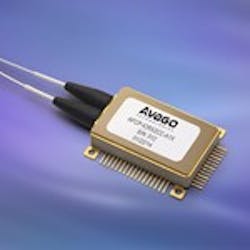Avago offers small PM-QPSK coherent receiver
- Baud rate up to 32 GBd
- High input dynamic range: THD < 5% at 3 mApp
- 10-dB signal attenuation range
- No active temperature control required
- Available for C-Band, L-Band, and C+L-Band
- Operating temperature range of -5 degrees C to +80 degrees C.
"Leveraging Avago's in-house InP and silica-on-silicon technology platforms and highly automated, sub-micron precision assembly platforms, we have delivered the highest level of integration and smallest footprint for our second generation PM-QPSK coherent receiver," said Stefan Rochus, director of optical components product marketing at Avago Technologies. "This demonstrates Avago's continued commitment to advancing our coherent receiver technology to address the 100G metro and emerging 200G/400G long-haul network applications."
"100G coherent technology is absolutely the key building block for transport networks-and not just for 100G deployments today but into the future. A very important part of the value of this one technology is that it spans 100G metro to 400G long-haul, and all those applications demand ever smaller size and greater functionality," said Karen Liu, principal analyst at Ovum. "The entire network infrastructure from metro to core is racing to keep up with traffic growth. Avago's receiver addresses a timely need as 100G metro-optimized and 400G long-haul systems come to market this year."
Avago is sampling the AFCP-ICRX2CC now, with general product availability targeted for July 2014. The company will display the new coherent receiver in Booth 3160 at OFC 2014 in San Francisco next week.
For more information on optical components and suppliers, visit the Lightwave Buyer’s Guide.
